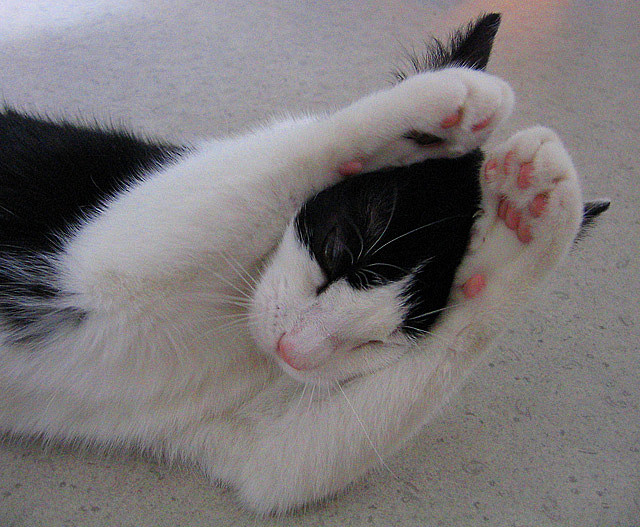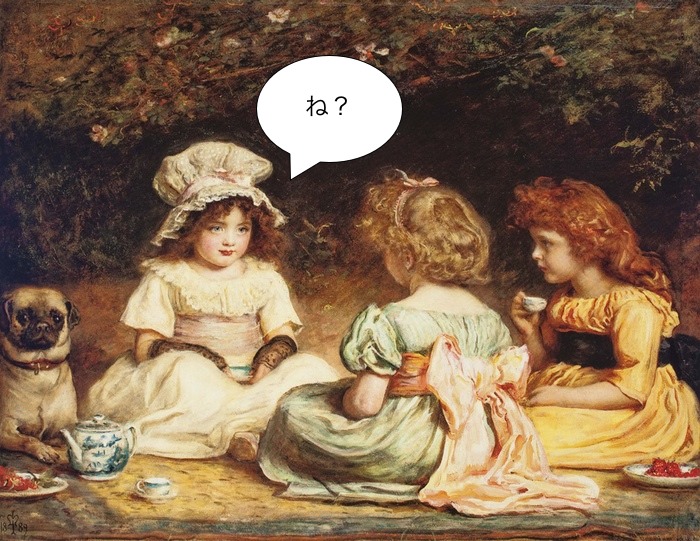"Hai. Hai. Ah Sou!" Whether studying Japanese or not, most people (especially B-class ninja movie buffs) are familiar at very least with these common mockeries of the Japanese language. Although overstated to the point of embarrassment, this stereotype, like most others, contains a grain of truth. Actually, this ridiculous stereotype can all be owed to the existence of what is known as "aizuchi" in the Japanese language.
"Aizuchi?" you ask. Yes, aizuchi does sound a bit like the deeply concerning goop you left in a Kleenex last time you got a severe case of Bronchitis (hopefully that doesn't happen often), but really, it's an essential component in minimizing all the awkward feels there might be when you first start communicating with Japanese people.
Even if you haven't heard of aizuchi, I guarantee that if you've ever had a conversation with one or more people, even in English, you've used it! The fact that there isn't even a proper translation of the word in English, though, just proves that native English speakers aren't as aware of it as Japanese speakers. I say hmmm.
What is Aizuchi?

So what is Aizuchi? Let us consult the oracle! Wikipedia defines aizuchi as: "the Japanese term for frequent interjections during a conversation that indicate the listener is paying attention and/or understanding the speaker." So, in other words, the word aizuchi refers to the short words or phrases like "u-huh," "yeah," and "I see" people usually use in conversation just to reassure others that they aren't talking to a lobotomized vegetable, or worse, getting the silent treatment – gasp!
According to an awesome study by genius linguist Laura Miller, the Japanese word aizuchi originally referred to "the alternating strikes of a mallet by a blacksmith and his apprentice."

Say What?
How did we jump from something as intense as blacksmithing to having a conversation, quite possibly over afternoon tea? Just imagine the blacksmith and his apprentice as two people having an ordinary conversation:
The blacksmith, being a wise old sage, starts with the first blow saying: "Like this!" Then, the apprentice follows the master's strike with another, saying: "Oh, like this!" But the blacksmith knows the apprentice doesn't get the whole picture, so he continues on: "This is how you do it child, like this!" And the apprentice follows once again, "Like this? I see!" he says. That is until the apprentice completely misses what he is aiming for, smashes his big toe with a mallet, and the blacksmith must repeat himself all over again.
The blacksmith, just as the speaker in a conversation, leads, while the apprentice, representing the subordinate position of the listener, follows his strikes. This is just like aizuchi in that the listener must constantly follow the speaker's utterances with signals of active listening. If not, bad things happen. Well, not really, but the speaker might repeat him/herself, or there might be an awkward silence, something most people try to avoid.
How to Use Aizuchi
In America, young children are often taught that having good listening skills means staying quiet but attentive when others are speaking. Let's try something. How many of you have been told "you should be seen and not heard"?

What's that I hear? Nothing? Oh good, looks like you're paying attention.
However, this is not the case in Japan. A unique aspect of Japanese conversation is the strong emphasis on active listening. In fact, as Miller points out, aizuchi occur after as many as two-thirds of utterances/statements in Japanese conversations (that's 3x's more than in English!) and even overlap with the speaker much of the time! Some Japanese children's books teach children that interjecting "hai" and other aizuchi makes a conversation go smoothly and harmoniously, just like oil on the axle of a wheel. Those who use aizuchi properly are even thought of as the best company! I mean really, doesn't everyone want to have that friend who literally hangs on every word of your rants about last week's episode of (insert generic anime here)? Don't lie, you know you do.
In order to better show you what aizuchi is, I searched for the word on YouTube. Can you guess what I got? Disgustingly adorable videos of kittens and small children practicing their aizuchi, of course (SASU GA NIHON)! This is just one demonstration of how aware Japanese people are of the presence of aizuchi in their language. I don't think I could even think of a word similar to it in English, not to mention pull up videos as sickeningly cute as these:
Cats can do anything. They can even do aizuchi better than me.
In this next video, an adorable baby boy practices his listening skills (aizuchi) while his father reads him a bedtime story. This baby shows he's interested not only through repeating the aizuchi "hai," but through excited screaming and indistinguishable noises! And he's not the only one who's excited, his parents are absolutely thrilled with his mad aizuchi skills, too.
As you can see, the way children in Japan are taught to listen is completely different from the way children in American and most other countries are taught. Interestingly enough, Miller points out that even China and Korea, although neighboring countries of Japan, practice listening behavior that more resembles "the West." The crazy thing is, for most people listening is so second nature that these cultural differences don't even cross their minds, and this can lead to some pretty sticky situations when members of differing cultures converse with each other.
Cultural Differences

There are some pretty big cultural differences between America and Japan in terms of what is thought of as good listening behavior, and as I'm sure you can imagine, this has been the cause of some pretty egregious misunderstandings in communications between the two countries.
In general, Japanese people tend to think of Americans as distracted, unengaged, heartless listeners (as in, OH LOOKY, A SQUIRREL!), while Americans have the tendency to think of the Japanese as being a little too eager or even pushy (as in, I HAVE NO TIME FOR YOUR GAMES, YANKEE). The great thing is, with just a little bit of assistance we can see that neither of these assumptions is necessarily true; the confusion lies in the differing definitions of what a good listener is from one culture to the other.

Another misunderstanding between Americans and Japanese often created by aizuchi culture is on the subject of agreement and disagreement. While most Japanese view the use of frequent aizuchi as an indication of a harmonious conversation and understanding, Americans tend to interpret the fury of constant head nodding and machine gun speed "hai hai hai" as a sign of absolute agreement, when in fact "hai" is more often used as an indicative of good listening rather than its literal meaning "yes."
For example, sometimes you'll be saying something in English to a Japanese person. They have no idea what you're saying, but because they're such good listeners, they're saying "yes, yes, yes" to everything you say (because that's the translation of hai, right?). At some point, you ask them an important question: "Do you want to join my Starcraft2 team?" They say "yes" not because they want to join your team (they really don't) but because they have no clue what you're saying (and they're good listeners). You think they've joined your team (you also apparently think they're from Korea and not Japan, but that's besides the point) but they don't. You can imagine how this would cause some problems down the road, especially with very important questions like the one in the example.

But the Japanese do have their way of disagreeing with other people, just like anyone else. It's how they show this disagreement that confuses people. For example, one common misconception that Americans have about Japanese people is that they never say "no." Of course, this isn't always the case, but there is some truth to this if you're thinking from a culturally Western perspective. Japanese people don't often use the direct translation of "no" to disagree with others the same way we do in English. In a culture where harmony in conversation (aizuchi) is so valued, think about how the absence of it could potentially affect the conversation. Often times, disagreement can be shown through the absence of the expected aizuchi. Hey, it's kind of like that time my boyfriend didn't respond to any of my questions after I played StarCraft2 for two weeks straight. It's not my fault he never showed up to team practices.
Disagreement doesn't end there, though. Another common way Japanese people show disagreement is through something I like to call "the hiss." "The hiss" is a sharp in-breath through the teeth, sometimes accompanied by a slight head turn, which replaces an expected aizuchi. At first this was hard for me to recognize because I thought it meant the other person was thinking, but slowly it became clear as day to me that this "hiss" means either the person doesn't agree, doesn't want to talk about a subject, or just doesn't know! This is super useful to know if you want to avoid making other people uncomfortable when speaking Japanese.
Aizuchi Examples
Okay, okay, now you know the definition of aizuchi and how important it is in the Japanese language, but let's learn a few of them so we can better recognize them in conversation, shall we? Right. The following is a list of commonly used aizuchi and their (very loose) translations, formal expressions marked with (F):
| Japanese | English |
|---|---|
| あ | Ah! |
| へえ | Really? |
| はい (F) | Yes |
| ええ (F) | That's correct; Right |
| うん | Yeah; Yep; Uh-huh |
| ふ~ん | Huh; Hmm |
| そうですか (F) | I see; Is that so? |
| そっか | I see; Is that so? |
| そうですよね (F) | That's right, huh? |
| そうだよね | That's right, huh? |
| そうですね (F) | I see; That's right |
| そうだね | I see; That's right |
| そうなんですか (F) | I see; Is that so? |
| そうなんだ | I see; Is that so? |
| ほんま (に)(Kansai) | Really? For real? |
| ほんと(う)(に) | Really?; Seriously? |
| なるほど(ね) | I see; Indeed; That's right… |
| Nodding | |
| Repeating | |
So yes, as you can see, there are a whole lot of ways to show you're listening and interested in Japanese! "Great!" you say, "But where do I put these things and when do I use what!?" The best way to master aizuchi is simply listening to Japanese conversations a lot and paying attention to how other people act when you are talking to them. The good news is that aizuchi is one of the fastest things foreign speakers' pick-up on, so, like G.I. Joe says, knowing about it is literally half the battle. That being said, here are some example conversations to help you to understand a little bit better:
Example 1: Informal Conversation
The following is an example of an informal conversation I recorded in which Kento, the speaker, tells a story about why he missed school to Miki, the listener:
K: 昨日さあ
M: うん
K: 朝さあ
M: うん
K: テストあったんやけどさあ
M: うん
K: こうなんか。 行ってる 途中にさあ。。なんかすげー(すごい)ね なんか ね 楽しそうな 車が
M: うん
K: 来たんよ
M: うん
K: 来たんやんか
M: うん
K: ならなんかもう。。すげー 楽しそうやからさあ
M: うん
K: もう。。 学校 行くの 嫌やなって 思ってさあ
M: ははうん
If you're analyzing this conversation from a native English speaker's perspective, you might feel like something a little funky is going on right from the beginning. Kento starts off his story with just the word kinou 昨日, 'yesterday,' and before you know it, Miki is interjecting 'uh-huh' here, there, all the way to timbuktu, everywhere, without Kento even finishing a complete thought or sentence.
If someone did this to you in English, it would probably feel strange, but in Japanese this is completely normal. Actually, I had the same two participants tell the same story in English, and the same thing happened. This just shows that aizuchi is not only a linguistic feature, but a cultural phenomenon. Crazy, huh? Also, can you point out where aizuchi occur in Japanese conversation the most? "Ding, ding, ding!" That's right! Aizuchi mainly occur after particles, さあ specifically occurs a lot in this conversation.
Example 2: Formal Conversation
In the following conversation, a woman (W) is contacting a man (M) to verify his knowledge of a future meeting.
W: すみません。 今連絡なんですけど。。
M: はい
W: あの、ご 都合を 先に 聞かなければと 思って。。
M: はい
W: あの、4 月の 3日。。
M: はい
W: 四時。 公園で。
M: はい
You might notice that although this is formal conversation, not all the sentences end in masu form. This is because when people actually speak to each other, they tend not to use complete sentences. Even so, it is possible to tell that this is a formal conversation just from the aizuchi used. As you can see in the chart above, some aizuchi are only used in formal conversations, this includes "hai." In the previous, informal conversation between Kento and Miki, the listener only uses "un" because of the informal nature of the conversation, but in the formal conversation, the man uses "hai" repeatedly to convey respect and a sense of formal distance. We can also see similarities between the two conversations in that aizuchi occurs very frequently, often after particles.
While it's easy to look at a conversation and say "oh yeah, that's aizuchi," it will take a bit of practice to get used to it. Most people, after all, have been living their entire lives in a non-aizuchi world. Paying attention to it and picking it out will be a great help towards making you better at aizuchi, but it won't happen overnight.
There are a few other things that will make you better, though. Here are some interesting points and guidelines about aizuchi that should make this whole concept easier… or harder. Not sure which.
- Aizuchi often occur at or near a final particle, especially ね (Basically if someone says ね they're asking for confirmation back from you and you're expected to respond with aizuchi ね).
- Aizuchi usually occur at a point of grammatical importance, such as the て form or other particles like が、は、けど、さあ, etc.
- It's OKAY to overlap a little bit with a speaker in Japanese; it shows you are listening well, not interrupting.
- Japanese people don't mind it if you use the same aizuchi over and over again, like "hai hai hai," in contrast to English where you look like a total jerk if you keep saying "u-huh, u-huh, u-huh" ALL THE TIME.
- If a Japanese person starts repeating him/herself a lot, that probably means they don't feel like you understand and you need to use more aizuchi.
- If a Japanese person starts repeating him/herself a lot, that probably means they don't feel like you understand and you need to use more aizuchi… and you need to use more aizuchi…aizuchi… ね.
- A lack of aizuchi is a signal of a lack of understanding or disagreement / displeasure. So, make sure you're doing the agreeing or disagreeing you want to do.
- Last of all, remember, aizuchi loves you.
Overall, using aizuchi, or at least recognizing its existence is really important to your journey on this crazy roller coaster ride known as learning Japanese. If you can use it properly, you'll look like a total pro even if you don't know much Japanese, and it'll probably be easier to communicate with Japanese people, avoid looking like a bowl of awkward sauce, and ultimately make friends! Yay, don't we all need more friends?

I also think understanding cultural differences in language like aizuchi is important in getting past all of the silly stereotypes we make about other people, and for me, that's one of the best parts of learning a foreign language. If you want to read more about aizuchi, I'd recommend Laura Miller's book: "Verbal Listening Behavior in Conversations Between Japanese and Americans." It's like bacon for linguists.
